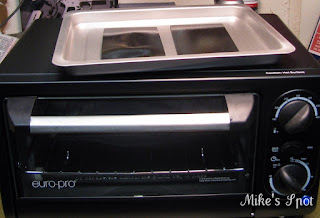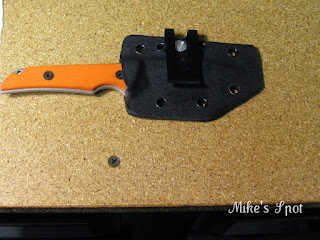 If you have owned guns and knives long enough, you have struggled with finding good holsters and sheaths that make carrying an assortment of gear easier. Leather alternatives are making big waves in the holster and sheath market, and kydex is leading the way. A decent kydex holster (like a blade-tech) runs about 30 bucks. Can you do better than that making it yourself? I decided to put my money where my mouth is and find out. I'll put the prices of everything I have had to buy, and will post results of the sheaths and holsters I make in yet another series that I will continue sporadically.
If you have owned guns and knives long enough, you have struggled with finding good holsters and sheaths that make carrying an assortment of gear easier. Leather alternatives are making big waves in the holster and sheath market, and kydex is leading the way. A decent kydex holster (like a blade-tech) runs about 30 bucks. Can you do better than that making it yourself? I decided to put my money where my mouth is and find out. I'll put the prices of everything I have had to buy, and will post results of the sheaths and holsters I make in yet another series that I will continue sporadically.First, making the kydex press is no small monetary endeavor. I designed my own out of particle board, a 2x4, and some old hinges I had laying around. A sheet of particle board will run you 15-20 dollars, and a 2x4 will cost you about 5. Decent hinges will cost you another 5 - so if you don't have materials around the house, you are already going to be committing to a 25-30 dollar investment. Keep that in mind, as complete kydex presses can be had for as little as 70 dollars.
Since I had all this material though, and I only needed foam for forming- I went for the home built route. Mine is a very simple design, and you can see exactly how I built it from the pictures. Feel free to copy it if you like.
 The foam coast me $23.90 from Knifekits.com - I went with the thermofoam mega foam. Cheaper options exist, but this stuff seems quite durable.
The foam coast me $23.90 from Knifekits.com - I went with the thermofoam mega foam. Cheaper options exist, but this stuff seems quite durable.Press completed, you will need material to create your holsters. I tried two different materials- Boltaron, a cheaper kydex alternative, and Kydex. I got both materials in .080 thickness, and got a total of three sheets.
The boltaron cost $5.30 from knife kits, and the Kydex cost $5.80 per sheet. As this project progresses, I will try to determine how much material is actually needed for different projects, but I can say my first endeavor, a knife sheath for my Kershaw Skyline, utilizes about 1/5th of a sheet, so about $1.06 dollars of Boltaron- which is the material I am working with first.
 You will also need a means of fastening your material together, so you will also need rivets / grommets, and a tool to set them in place. That will run you 12.95 and 11.95 respectively, also from knife kits. I also ordered some belt clips, costing 1.85 each.
You will also need a means of fastening your material together, so you will also need rivets / grommets, and a tool to set them in place. That will run you 12.95 and 11.95 respectively, also from knife kits. I also ordered some belt clips, costing 1.85 each.Obviously, this is totaling up quickly. Ebay has people making the Kershaw Skyline Kydex Sheath for 27 bucks, and it is a neck knife configuration, not a belt knife. It is also made of the cheaper, .060 kydex. However - I'm starting to wonder if I should have just bought a blade-tech and a skyline kydex sheath off of ebay.
already we have spent:
foam: 23.90
Kydex (.080) 5.80 (x2 - 11.60)
Boltaron (.080) 5.30
Grommets 12.95 (for 100, 1/4 inch)
Grommet Tool 11.95
Belt clip 1.85
chicago screws 4.00 (10 pack)
shipping 9.00
TOTAL 80.55
My first Skyline sheath will consume the following materials:
Boltaron 1.06 (1/5th a sheet)
Grommets .13 (8x)
chicago screw .40 (1x)
belt clip 1.85 (1x)
TOTAL 4.26
With that in mind, making the sheath myself gives me 22.74 to amortize out the initial investment cost.
Assuming we are comparing my sheath to a comparable 'ebay one', I need to make 4 sheaths to come out ahead after initial investment. Assuming you also had to amortize out the cost of additional press materials, you are taking another sheath.
 Clearly, going the 'make your own' route is not a small endeavor. Money can be saved by making belt clips out of holster material, and not buying pre-fabricated ones, for instance. Prices out of the way, we now enter the actual holster or sheath making process. You will need to measure, cut, form, and finish the material to go from a raw sheet of kydex or similar, into a useful end product.
Clearly, going the 'make your own' route is not a small endeavor. Money can be saved by making belt clips out of holster material, and not buying pre-fabricated ones, for instance. Prices out of the way, we now enter the actual holster or sheath making process. You will need to measure, cut, form, and finish the material to go from a raw sheet of kydex or similar, into a useful end product.All said and done, the first sheath took me 50 minutes. I suspect making another one would take substantially less time, especially if you took a few minutes to really lay out the design you want. You can see from mine that my grommets were more of an afterthought, but the sheath is still quite functional.

With kydex cut, you now need to heat it so it becomes malleable. I use an old toaster oven. You can use your regular house oven, or a heat gun if you have one. I tried a hair dryer, but was not able to heat the material sufficiently for good molding. A hair dryer might be sufficient for spot heating during final fitting, but I couldn't say that with certainty.
With the oven preheated to about 300 degrees, the material took 3-4 minutes to become pliable enough for forming. Be careful not to overheat the material, as it has some nasty gasses that can be emitted if you get
 the temperature over 425 degrees F. Then line the material up how you would like it with your knife or object sandwiched between them and quickly clamp down your press.
the temperature over 425 degrees F. Then line the material up how you would like it with your knife or object sandwiched between them and quickly clamp down your press.I use a quick clamp for this, and it seems to work just fine. I let the material cool for about 10 minutes before opening the press back up. I don't know if it needs this long to cool, but I was able to get pretty clean fill out by giving it more than a couple minutes.
Once the material has full formed around your object, the sheets will stick together slightly. This appears to be a normal part of the process. You can start marking up the kydex with the location of grommets and the
 final form you would like the sheath / holster to take.
final form you would like the sheath / holster to take.I wanted a plain, horizontal carry option for small of back carry. This setup is also easy to throw on my safety harness during hunting season for vertical blade-up carry. I used grommets on either side of the clip to give it additional rigidity in staying locked into the desired position.
All in all, I'm pretty pleased with how this came out. This is the first project I made and was the first time I handled Boltaron and Kydex. Obviously, it is a very simple process to get out a usable product, even on the first attempt.

For final finishing of the material, I used a grinding wheel. On my second project (A holster for a cz-82) I also used medical sheers to help form the material in the rough shape I wanted. I finished the material off with a rub down with some emery paper.
The remaining 4/5ths of a sheet was more than enough to do the holster for the CZ, and I have enough material left over to probably make another knife sheath.
This project was not without its fair share of rookie mistakes. First- The boltaron is very easy to work with.
 in retrospect I wouldn't have even bothered buying the kydex, as the boltaron seems to do everything the kydex does just as well, at a lesser price.
in retrospect I wouldn't have even bothered buying the kydex, as the boltaron seems to do everything the kydex does just as well, at a lesser price. Second, you will need chicago screws in varying lengths. Get 3/8ths and also get a few 1/2 inch. When you are placing spacers in a gun holster, and need to fasten a clip, the width of the material stacks up quickly and your short 3/8th screws will not be sufficient.
Third- order clips. These were surprisingly difficult to form well, despite the sheaths and holsters being super easy. I reformed the same piece of boltaron 4 times trying to make decent clips, and had a heck of a time of it. Belt straps are a simple affair- but if you are trying to make a J-type clip, its going to be a PITA.
Fourth and final mistake- Order more material. I did two projects in about an afternoon (counting building the press) and only have 2 more sheets of material. I should have ordered 6 or more sheets. You get a per unit discount, and you'll have enough material to really make a bunch of stuff.
OWB holsters I think are an easier endeavor than IWB- but I started with an IWB because - frankly, that was what I needed. The material is forgiving, and as long as you aren't cutting odd shapes or drilling random holes, you can always heat it back up and reform it.
I would give this project a solid buy recommendation, and urge people to get the cheaper material. .060 material may also be sufficient for most applications, but for the extra few pennies I think it is best to just keep the middle of the road thickness of .080.
Hiç yorum yok:
Yorum Gönder